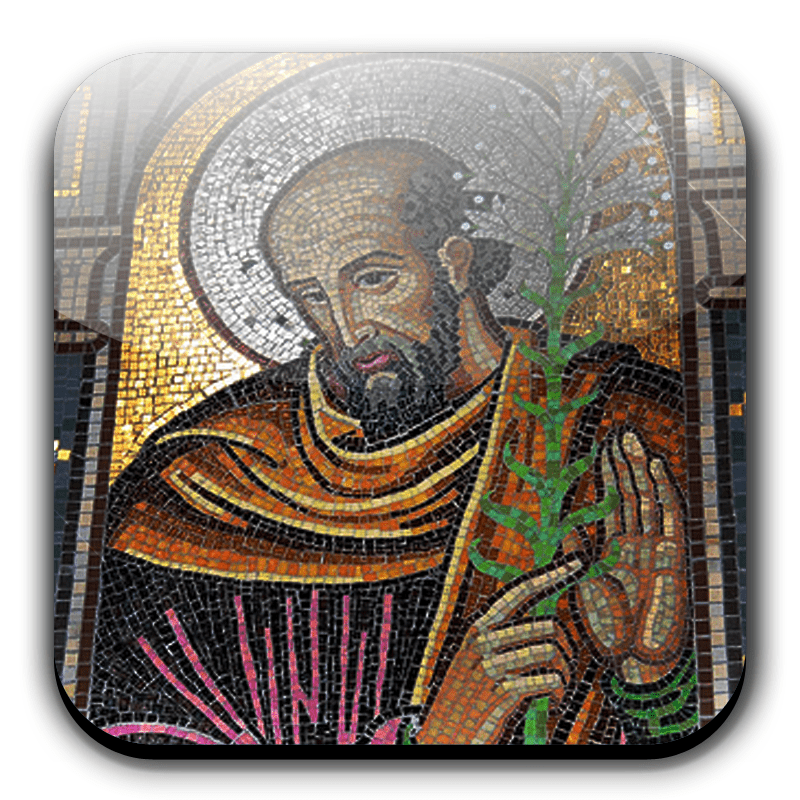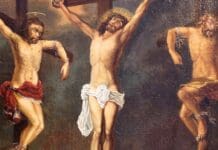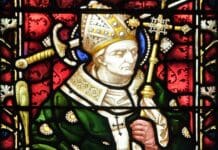Saint Malachy was a bishop famous for writing very famous prophecies of the popes. Also listed as Mael Maedoc ua Morgair or Maolrnhaodhog ua Morgair, Malachy was born in Armagh, Ireland, in 1095. He was ordained by St. Cellach or Celsus of Armagh in 1132 and studied under Bishop St. Maichius of Lismore. Malachy reformed ecclesiastical discipline and replaced the Celtic liturgy with the Roman when he served as abbot of Bangor.
In 1125 St. Malachy was made bishop of Connor, using Bangor as his seat. He also established a monastery at Iveragh, Kerry. He was named archbishop of Armagh in 1129.
In 1139 he went to Rome to give an account of the affairs of his diocese to the pope, Innocent II, who promised him two palliums for the metropolitan Sees of Armagh and Cashel. While at Rome, he received (according to the Abbé Cucherat) the strange vision of the future wherein was unfolded before his mind the long list of illustrious pontiffs who were to rule the Church until the end of time. The same author tells us that St. Malachy gave his manuscript to Innocent II to console him in the midst of his tribulations, and that the document remained unknown in the Roman Archives until its discovery in 1590 (Cucherat, “Proph. de la succession des papes”, ch. xv). They were first published by Arnold de Wyon, and ever since there has been much discussion as to whether they are genuine predictions of St. Malachy or forgeries. The silence of 400 years on the part of so many learned authors who had written about the popes, and the silence of St. Bernard especially, who wrote the “Life of St. Malachy”, is a strong argument against their authenticity, but it is not conclusive if we adopt Cucherat’s theory that they were hidden in the Archives during those 400 years.
These short prophetical announcements, in number 112, indicate some noticeable trait of all future popes from Celestine II, who was elected in the year 1143, until the end of the world. They are enunciated under mystical titles. Those who have undertaken to interpret and explain these symbolical prophecies have succeeded in discovering some trait, allusion, point, or similitude in their application to the individual popes, either as to their country, their name, their coat of arms or insignia, their birth-place, their talent or learning, the title of their cardinalate, the dignities which they held etc.
For example, the prophecy concerning Urban VIII is Lilium et Rosa (the lily and the rose); he was a native of Florence and on the arms of Florence figured a fleur-de-lis; he had three bees emblazoned on his escutcheon, and the bees gather honey from the lilies and roses. Again, the name accords often with some remarkable and rare circumstance in the pope’s career; thus Peregrinus apostolicus (pilgrim pope), which designates Pius VI, appears to be verified by his journey when pope into Germany, by his long career as pope, and by his expatriation from Rome at the end of his pontificate.
Those who have lived and followed the course of events in an intelligent manner during the pontificates of Pius IX, Leo XIII, and Pius X cannot fail to be impressed with the titles given to each by the prophecies of St. Malachy and their wonderful appropriateness: Crux de Cruce (Cross from a Cross) Pius IX; Lumen in caelo (Light in the Sky) Leo XIII; Ignis ardens (Burning Fire) Pius X. There is something more than coincidence in the designations given to these three popes so many hundred years before their time. We need not have recourse either to the family names, armorial bearings or cardinalatial titles, to see the fitness of their designations as given in the prophecies. The afflictions and crosses of Pius IX were more than fell to the lot of his predecessors; and the more aggravating of these crosses were brought on by the House of Savoy whose emblem was a cross. Leo XIII was a veritable luminary of the papacy. The present pope is truly a burning fire of zeal for the restoration of all things to Christ.
The last of these prophecies concerns the end of the world and is as follows: “In the final persecution of the Holy Roman Church there will reign Peter the Roman, who will feed his flock amid many tribulations, after which the seven-hilled city will be destroyed and the dreadful Judge will judge the people. The End.”
It has been noticed concerning Petrus Romanus, who according to St. Malachy’s list is to be the last pope, that the prophecy does not say that no popes will intervene between him and his predecessor designated Gloria olivæ. It merely says that he is to be the last, so that we may suppose as many popes as we please before “Peter the Roman”. Cornelius a Lapide refers to this prophecy in his commentary “On the Gospel of St. John” (C. xvi) and “On the Apocalypse” (cc. xvii-xx), and he endeavours to calculate according to it the remaining years of time.
St. Malachy died on November 2 in St. Bernard’s arms. St. Bernard declared him a saint, an action confirmed in 1190 by Pope Clement III.


















Greetings in the Resurrected Christ!
Jesus Christ has raised me from the dead to the office of Peter the Roman.
When I originally commented I clicked the -Notify me when new comments are added- checkbox and now each time a comment is added I get four emails using the same comment. Is there any way you’ll be able to eliminate me from that service? Thanks!
cheap jordans
You can find some fascinating points in time in this article but I don’t know if I see all of them center to heart. There is some validity but I will take hold opinion until I look into it further. Decent post , thanks and we want a lot more! Added to FeedBurner too
cheap jordans online
We have entered the “age to come” foretold by Jesus in Mark 10:30, the Glorious Manifestation of Our King, Lord, and Savior Jesus Christ. (the Harmonious Gospel of Saint Mark, chapter 10, verse 30)
http://risen-from-the-dead.forumotion.com/